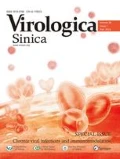Abstract
Banana bunchy top virus (BBTV) poses a serious danger to banana crops worldwide. BBTV-encoded protein B4 is a determinant of pathogenicity. However, the relevant molecular mechanisms underlying its effects remain unknown. In this study, we found that a functional peptide could be liberated from protein B4, likely via proteolytic processing. Site-directed mutagenesis indicated that the functional processing of protein B4 is required for its pathogenic effects, including dwarfism and sterility, in plants. The released protein fragment targets host proteins, such as the large subunit of RuBisCO (RbcL) and elongation factor 2 (EF2), involved in protein synthesis. Therefore, the peptide released from B4 (also a precursor) may act as a non-canonical modifier to influence host–pathogen interactions involving BBTV and plants.





Similar content being viewed by others
References
Alcaide-Loridan CJ, Jupin I (2012) Ubiquitin and plant viruses, let’s play together! Plant Physiol 160:72–82
Bhogaraju S, Kalayil S, Liu Y, Bonn F, Colby T, Matic I, Dikic I (2016) Phosphoribosylation of ubiquitin promotes serine ubiquitination and impairs conventional ubiquitination. Cell 167:1636–1649
Burns TM, Harding RM, Dale JL (1995) The genome organization of banana bunchy top virus: analysis of six ssDNA components. J Gen Virol 76:1471–1482
de Torres Zabala M, Littlejohn G, Jayaraman S, Studholme D, Bailey T, Lawson T, Tillich M, Licht D, Bölter B, Delfino L, Truman W, Mansfield J, Smirnoff N, Grant M (2015) Chloroplasts play a central role in plant defence and are targeted by pathogen effectors. Nat Plants 1:15074
Endo T, Ishida S, Ishikawa N, Sato F (2008) Chloroplastic NADPH dehydrogenase complex and cyclic electron transport around photosystem I. Mol Cells 25:158–162
Fondong VN (2013) Geminivirus protein structure and function. Mol Plant Pathol 14:635–649
Guarino LA, Smith G, Dong W (1995) Ubiquitin is attached to membranes of baculovirus particles by a novel type of phospholipid anchor. Cell 80:301–309
Hanley-Bowdoin L, Bejarano ER, Robertson D, Mansoor S (2013) Geminiviruses: masters at redirecting and reprogramming plant processes. Nat Rev Microbiol 11:777–788
Komander D, Rape M (2012) The ubiquitin code. Ann Rev Biochem 81:203–229
Kotewicz KM, Ramabhadran V, Sjoblom N, Vogel JP, Haenssler E, Zhang M, Behringer J, Scheck RA, Isberg RR (2017) A single legionella effector catalyzes a multistep ubiquitination pathway to rearrange tubular endoplasmic reticulum for replication. Cell Host Microbe 21:169–181
Mandadi KK, Scholthof KB (2013) Plant immune responses against viruses: how does a virus cause disease? Plant Cell 25:1489–1505
Qiu J, Sheedlo MJ, Yu K, Tan Y, Nakayasu ES, Das C, Liu X, Luo ZQ (2016) Ubiquitination independent of E1 and E2 enzymes by bacterial effectors. Nature 533:120–124
Randow F, Lehner PJ (2009) Viral avoidance and exploitation of the ubiquitin system. Nat Cell Biol 11:527–534
Rojas MR, Jiang H, Salati R, Xoconostle-Cázares B, Sudarshana MR, Lucas WJ, Gilbertson RL (2001) Functional analysis of proteins involved in movement of the monopartite begomovirus, tomato yellow leaf curl virus. Virology 291:110–125
Sun DJ, Sun H, Wei HY, Fan XX, Cai WQ, Tian YC (2002) Functional analysis of DNA 4 coding region from a Chinese Zhangzhou isolate of banana bunchy top virus. Prog Nat Sci 12:426–430
Wanitchakorn R, Hafner GJ, Harding RM, Dale JL (2000) Functional analysis of proteins encoded by banana bunchy top virus DNA-4 to -6. J Gen Virol 81:299–306
Wu RY, Su HJ (1990) Purification and characterization of banana bunchy top virus. J Phytopathol 128:153–160
Zhuang J, Coates CJ, Mao Q, Wu ZJ, Xie LH (2016) The antagonistic effect of Banana bunchy top virus multifunctional protein B4 against Fusarium oxysporum. Mol Plant Pathol 17:669–679
Zorzatto C, Machado JP, Lopes KV, Nascimento KJ, Pereira WA, Brustolini OJ, Reis PA, Calil IP, Deguchi M, Sachetto-Martins G, Gouveia BC, Loriato VA, Silva MA, Silva FF, Santos AA, Chory J, Fontes EP (2015) NIK1-mediated translation suppression functions as a plant antiviral immunity mechanism. Nature 520:679–682
Acknowledgements
This work was supported by grants from the Natural Science Foundation of China (No. 31301641 to J.Z.) and the Program for Qualified Personnel of Taiwan Strait West Coast (No. K8812007 to L.H.X.). We are grateful to Haitao Wang for assistance with TEM, Dr. Zhixin Liu for providing the anti-B3 (coat protein) antibody, and Dr. Zhenguo Du for valuable discussions.
Author information
Authors and Affiliations
Contributions
JZ conceived of the entire project. JZ and WL performed the vast majority of experiments. PS generated some plasmid constructs and performed Western blotting. TW was involved in TEM analyses. ZW provided materials, including banana samples. LX provided constructive suggestions and co-supervised the project. JZ generated or guided all figures. JZ and CJC interpreted the data and wrote the manuscript.
Corresponding authors
Ethics declarations
Conflict of interest
The authors declare that they have no conflict of interest.
Animal and Human Rights Statement
The authors declare that they have no conflict of interest. This article does not contain any studies with human or animal subjects performed by any of the authors.
Electronic supplementary material
Below is the link to the electronic supplementary material.
Rights and permissions
About this article
Cite this article
Zhuang, J., Lin, W., Coates, C.J. et al. Cleavage of the Babuvirus Movement Protein B4 into Functional Peptides Capable of Host Factor Conjugation is Required for Virulence. Virol. Sin. 34, 295–305 (2019). https://doi.org/10.1007/s12250-019-00094-4
Received:
Accepted:
Published:
Issue Date:
DOI: https://doi.org/10.1007/s12250-019-00094-4




